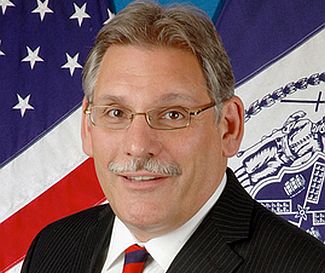
By Robert S. Martinez, Deputy Commissioner, New York City Police Department
Over the past 12 months, the all-electric vehicle revolution has accelerated to the point that there should be little doubt in anybody’s mind that EV’s are the future of government fleets, if not the world’s. Now, it’s time that every government fleet consider getting on board. What makes me say that? Four game-changing news items since the beginning of last year:
• The introduction of affordable electric vehicles that have a range of over 200 miles. One year ago, I never would have given the green light to start buying fully electric vehicles for the New York City Police Department because their range was too limited. But then Chevrolet brought its brand-new Bolt hatchback to market last Spring with a range of 238 miles, and a suggested retail price of less than $37,000, but under $30,000 with federal and state incentives. And when I test drove it and found that it performed well, for me it was a game changer. Currently these new electric vehicles can be used for non-patrol functions, traffic control, school safety, and administrative assignments.
• More than 30 cities united last year to research a joint bid on more than 100,000 EVs to achieve lower prices. As originally formed, the buying consortium consisted of cities in three West Coast states – California, Washington, and Oregon – and the Canadian province of British Columbia, with the idea combining on a joint request for pricing for up to 24,000 vehicles from several EV manufacturers. Led by Los Angeles Mayor Eric Garcetti, the group formed in response to complaints by manufacturers that consumer demand for EVs is weak.
But by March of last year, more than 30 cities from all across the U.S. had joined the ad hoc group, raising the potential buy to 114,000 vehicles. That’s about three-quarters of the total U.S. sales of plug-in EVs in 2016. The cities include New York, Chicago, Houston, Boston, Denver and Kansas City. That kind of serious interest and potential buying power was my game changer number two.
• Expanding recharging infrastructure. Game-changer number three was the signing of a pact by seven western states last year to create a 5,000-mile network of fast-charge stations on interstate highways in the region. The lack of fast-charging stations has been another reason people have been reluctant to buy EVs. This western state initiative is in addition to a number of state and city governments all around the country that are investing in fast-charging infrastructure, including New York, Chicago and Atlanta, and even the state of Vermont.
• Automakers’ plans for significantly expanded EV production, at a profit. To date, EV sales have been small and the number was limited. But last month, Ford announced plans to invest $11 billion to introduce 40 electrified vehicles by 2022. That followed GM’s October announcement that it will add 20 new battery EVs to its global lineup by 2023. GM Chief Executive Mary Barra even promised investors they will make money selling electric cars. This is game changer number four, because in the past EV profits were low, if there were any at all, and this shows that car-makers believe that making and selling EVs will go mainstream. Toyota and Volkswagen are getting into the game, Nissan is still in it, and even Tesla is about to release an affordable model.
Propelling the revolution are commitments by China, Western Europe and California to lower carbon emissions to reduce unhealthy pollution and fight global warming. China, India, France, the United Kingdom and Norway all are planning to phase out internal combustion engine vehicles over the next twenty years. Meanwhile, battery technology and R&D partnerships are advancing every day to reduce cost and add range.
But beyond being a cure for pollution, EVs offer government fleets tremendous savings. A study conducted at the University of Michigan and published last month found that fuel costs for EVs are less than half that of ICE-powered vehicles. That’s on top of the fact that EV maintenance is considerably cheaper, too. As reported in Forbes magazine:
“The average cost to operate an EV in the United States is $485 per year, while the average for a gasoline-powered vehicle is $1,117, according to the study by Michael Sivak and Brandon Schoettle of Michigan’s Transportation Research Institute.
“This study only examined fuel costs, but the maintenance cost for electric vehicles has also been found to be lower because they have fewer moving parts, no exhaust system, less need for cooling, less abrasive braking options, and no need to change oil, fan belt, air filters, timing belts, head gaskets, cylinder heads and spark plugs.”
Wow! So, before EVs, when could you have saved money, reduced greenhouse gases, enjoyed great performance, and maybe had someone give you money to buy vehicles? In my 32 years of repairing and managing the largest police fleet in the USA, I would say never!
To the best of my knowledge, the NYPD is the greenest police fleet in the world. Today, 18% of the NYPD fleet’s fleet of 10,000 vehicles are hybrids. The department just purchased 31 fully electric Chevy Bolts and has put 10 of them into service over the past month.
We’re very excited to see the results and feedback from this new program. One of the biggest hurdles was installing the charging stations, which cost between $700 to $1,500 each. Some charge only one vehicle while some can charge up to two at the same time. Installation of the charging station was done by our in-house electricians. It took them about six months to have 10 two-vehicle stations installed around the city – but there are even government subsidies for that!
Many other police departments across the U.S. are testing and adding both hybrids and EVs to their fleets. To bring these vehicles into a fleet represents challenges and a steep learning curve, but that’s true of every revolution, and the potential benefits of this one are great.
There are going to be heroes in this revolution. My advice to government fleet managers everywhere is to embrace it, because there’s no stopping it. Your choice is simple: get on board or be left behind!



